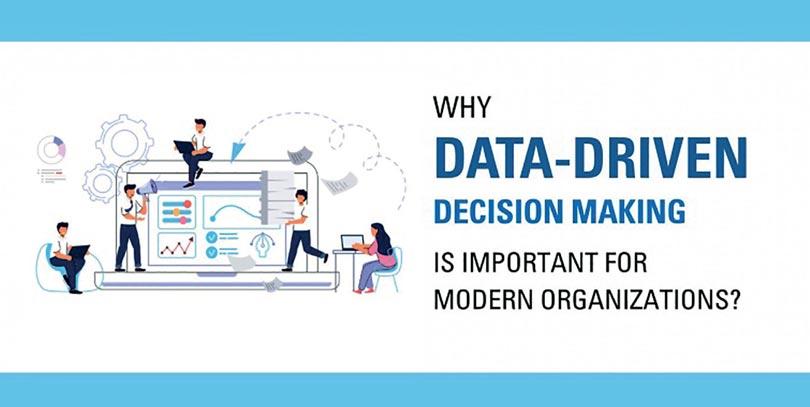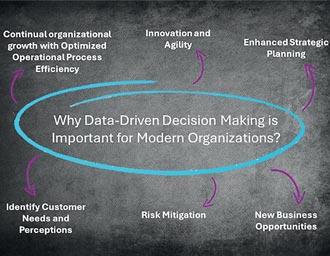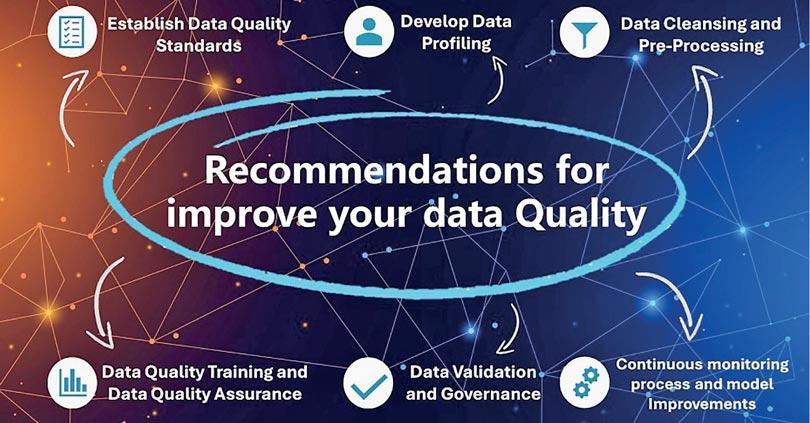Tuesday Mar 04, 2025
Tuesday Mar 04, 2025
Thursday, 30 May 2024 00:09 - - {{hitsCtrl.values.hits}}

 Organizations must be able to make well-informed decisions based on data-driven insights to succeed and keep a competitive edge in the highly competitive business environment of today.
Organizations must be able to make well-informed decisions based on data-driven insights to succeed and keep a competitive edge in the highly competitive business environment of today.
In the modern world, banking and finance, insurance, telecommunication, and manufacturing industries have identified solving complex problems based on real-world policies and practices as a major challenge. This is because modern industries are integrated with massive amounts of data generated from various sources, such as social media interactions, sensors and scanner readings, weblogs, Customer Transactions (CT), Customer Relationship Marketing (CRM), and so on.
Therefore, solving complex problems using traditional methods has posed a significant challenge.
Why data-driven decision-making is important?
Data-driven decision-making is a process of using data to make informed decisions to drive business growth. However, it creates a powerful tool for business success in today’s dynamic and data-driven environment. Therefore, the ability to analyze complex data with Data-driven decision-making has greater opportunities to identify future market demands and trends.
To achieve sustainable growth, data-driven decision-making entails examining data and making operational and strategic choices. Additionally, by utilizing data analytics, businesses can obtain insightful knowledge and make the finest managerial decisions that complement their plans.
In the real world, successfully implementing the Data-driven decision-making process requires a combination of technological investment, organizational cultural change, and strategic leadership. Furthermore, to extract the actual insights from your information, it must be mapped one-to-one with relevance to your organization’s goals and objectives; especially, identifying proper methods for extracting, formatting, and analyzing insights for enhanced data-driven decision-making is essential.
Data-Driven Decision-Making for the Real World
Presently, artificial intelligence (AI)-powered data-driven decision-making methodologies are essential for drawing useful conclusions and motivating data-driven decision-making from these enormous datasets. In particular, data science techniques are a vital resource that may be extensively utilized to pinpoint the significant attributes needed to form future advertising decisions under various economic regulations and practices. To extract relevant insights and support well-informed decision-making, effective data science approaches require a combination of domain knowledge, analytical abilities, and technical ability.
Data-driven decision-making has numerous real-world applications across various industries and sectors. Some of the examples are:
In the healthcare industry, Data-driven decision-making techniques are used to analyze patient data, medical records, and clinical outcomes to improve patient care, optimize treatment plans, and enhance operational efficiency.
Healthcareproviders use data analytics to identify trends in patient populations, predict disease outbreaks, and personalize treatment regimens.
In the financial services sector, Data-driven decision-making techniques are widely used to analyze stock market and financial market trends, different economic indicators, and customer transactions to inform investment decisions, risk management strategies, assess credit risk, and fraud detection efforts.
Textile Manufacturers use Data-driven decision-making techniques to optimize production processes, reduce costs, and improve product quality. Furthermore, by analyzing marketing data, production metrics, and supply chain data, manufacturers can identify inefficiencies, minimize downtime, and optimize resource allocation to maximize productivity and profitability.
In the transportation and logistics management industry, data-driven decision-making process is used to optimize route planning, fleet management, and supply chain operations. Furthermore, transportation companies use data science analytic techniques to track vehicle performances, monitor fuel consumption, and optimize delivery schedules to improve efficiency and reduce costs.
Government agencies use Data science techniques to improve service quality, optimize resource allocation, and enhance policy-making processes; especially, by analyzing data on citizen demographics, service usage, and community needs, government agencies can identify areas for improvement, allocate resources effectively, and address emerging challenges.
Key steps for implementing a Data-driven decision-making process
Implementing a data-driven decision-making process for organizations is crucial for analyzing data on customer behavior, market trends, and competitor performance in today’s data-rich environment. Furthermore, by leveraging data analytics and insights, organizations can make informed decisions to drive strategic growth, enhance operational efficiency, and improve overall performance more accurately. Additionally, the decision-making process allows organizations to mitigate risks during economic and financial crises and capitalize on opportunities more effectively.
Enhancing your data-driven decision-making strategy involves several key steps.
Define Clear objectives
As an initial step, clearly define your objectives to achieve targets through a data-driven decision-making process. Furthermore, align these objectives with your organization’s goals and priorities to ensure focus and direction.
Data Identification, Data Collection, and Storage ( i.e Data Warehousing)
After identifying their real needs, organizations must establish robust data collection mechanisms and infrastructure to gather relevant data from various sources.
Data scientists extensively employ machine learning algorithms, statistical and mathematical methodologies, and data visualization tools to examine and comprehend data, identify trends, and derive practical insights.
Based on the insights generated from data analysis, decision-makers formulate strategies and develop action plans to achieve their desired outcomes.
Organizations continuously monitor key metrics and performance indicators to track progress, evaluate the effectiveness of decisions, and make adjustments as needed.

Why Data-Driven Decision Making is Important for Modern Organizations?
Data-driven decision-making is essential for modern organizations, which provides the capabilities to generate real-time insights and predictions to optimize their performance.
Several factors directly impact the decision-making process in the contemporary business sector.
Continual organizational growth with Optimized Operational Process Efficiency
Data-driven decision-making has empowered organizations to achieve key insights based on operations, and departmental activities. Indeed, by analyzing marketing data based on key performance indicators (KPIs) with short-term and long-term goals, organizations can identify their inefficient practices, bottlenecks and limitations, and areas for future improvements. This enables them to identify customer needs, streamline operations, reduce costs and waste, and enhance overall efficiency.
The decision-making process allows us to develop more effective strategic plans by leveraging data to understand market demands and trends, customer preferences, and competitive landscapes. This enables organizations to align their strategies with market demands and open new growth opportunities for their customers.
Decision-making based on data leads to discovering new business directions and uncovering opportunities to expand your organizational growth, create new professional connections, and develop innovations. It will give you a panoramic view of your business’s core activities.
Due to the quickly changing market dynamics, identifying emerging trends, and evolving customer needs is essential. Data-driven decision-making helps to understand the customers’ behavior, preferences, and needs and increases customer satisfaction and loyalty. So, based on the Data-driven decision-making results, organizations can tailor their products, services, and marketing strategies to better meet customer expectations.
Data-driven insights enable organizations to identify and mitigate risk factors more effectively. Furthermore, by doing predictive analytics based on historical data, organizations can proactive measures to mitigate their potential risks and, minimize the likelihood of negative outcomes.
Data-driven decision-making creates a culture of innovation and agility within organizations by encouraging experimentation, iteration, and adaptation based on data-driven insights.
What are the challenges in the data-driven decision-making process?
Due to the complexities of modern data such as large volume, uncertainty, poor quality, dimensionality, privacy, security concerns, and the complexity of algorithms, data-driven decision-making creates challenges for organizations to make informed decisions. These limitations stem from the characteristics of contemporary data environments. Therefore, addressing these limitations requires a hybrid technical expertise, domain knowledge, and ethical considerations.
By leveraging advanced techniques, preprocessing methods, and best practices, organizations can mitigate the impact of these limitations and extract valuable insights from the modern data environment responsibly and effectively ensuring competitiveness in the marketplace.
Future challenges on data-driven decision-making process:
The quality of the data measures how well the dataset meets the criteria for accuracy, validity, consistency, uniqueness, and fitness. Furthermore, limited availability and poor data quality, including inaccuracies, inconsistencies, and incompleteness, can undermine the effectiveness of data-driven decision-making.
Given the paramount importance of data privacy and security, especially in the context of government regulations, it is imperative to prioritize these aspects. So, organizations must implement robust security measures to protect sensitive data and comply with regulatory requirements for data-driven decision-making.
Organizations must take action to maintain data quality, integrity, and security with proper data governance. A lack of data standards, policies, and procedures, can lead to inconsistencies, inefficiencies, and risks.

A lack of data literacy among users can hinder the adoption and effectiveness of data-driven decision-making.
Recommendations for improve your data Quality
According to Melody Chien, Senior Director Analyst, “Data quality is directly linked to the quality of decision making”. So, prioritizing data quality initiatives to ensure that data is accurate, consistent, and reliable is essential; especially, Implementing data quality management tools and processes to monitor, cleanse, and enhance data quality across the organization is significant.
The major tips to improve data quality as follows
Organizations need to define their data quality standards and criteria to evaluate the accuracy, completeness, consistency, and timeliness of data. These standards should be aligned with organizational goals, business processes, key performance indicators (KPIs), and data assets.
Develop Data Profiling
Data quality profiling is the process of examining the structure, content, and relationships within your data to assess its quality and integrity. It helps to identify the corrective actions and provides valuable insights that can be presented to the business to drive ideation on improvement plans.
As an initial step, identifying the outliers and Implementing data cleansing techniques to correct errors, inconsistencies, and inaccuracies in your data is essential; especially, identifying and removing duplicate records, standardizing data formats, and data validating are important.
Providing training and knowledge to your employees on the importance of data quality and best practices for maintaining high-quality data is important; especially, this helps to foster a culture of data quality within your organization.
Furthermore, establishing a data quality assurance process to systematically evaluate and improve the quality of your data is also essential. This involves conducting regular audits, reviews of your data, assessments, and implementing corrective actions.
Data validation refers to the process of ensuring the accuracy and quality of data. Data validation ensures the data entered into the systems meets predefined criteria and constraints including checks for data type, format, range, and referential integrity.
Treat data quality as an ongoing process rather than a one-time initiative. Continuously monitoring, measuring, and improving the quality of your data over time to ensure the evolving needs of your organization are also essential.
By following these best practices, organizations can enhance the quality of their data and ensure that it remains accurate, reliable, and fit for purpose.

Discover Kapruka, the leading online shopping platform in Sri Lanka, where you can conveniently send Gifts and Flowers to your loved ones for any event including Valentine ’s Day. Explore a wide range of popular Shopping Categories on Kapruka, including Toys, Groceries, Electronics, Birthday Cakes, Fruits, Chocolates, Flower Bouquets, Clothing, Watches, Lingerie, Gift Sets and Jewellery. Also if you’re interested in selling with Kapruka, Partner Central by Kapruka is the best solution to start with. Moreover, through Kapruka Global Shop, you can also enjoy the convenience of purchasing products from renowned platforms like Amazon and eBay and have them delivered to Sri Lanka.
Discover Kapruka, the leading online shopping platform in Sri Lanka, where you can conveniently send Gifts and Flowers to your loved ones for any event including Valentine ’s Day. Explore a wide range of popular Shopping Categories on Kapruka, including Toys, Groceries, Electronics, Birthday Cakes, Fruits, Chocolates, Flower Bouquets, Clothing, Watches, Lingerie, Gift Sets and Jewellery. Also if you’re interested in selling with Kapruka, Partner Central by Kapruka is the best solution to start with. Moreover, through Kapruka Global Shop, you can also enjoy the convenience of purchasing products from renowned platforms like Amazon and eBay and have them delivered to Sri Lanka.